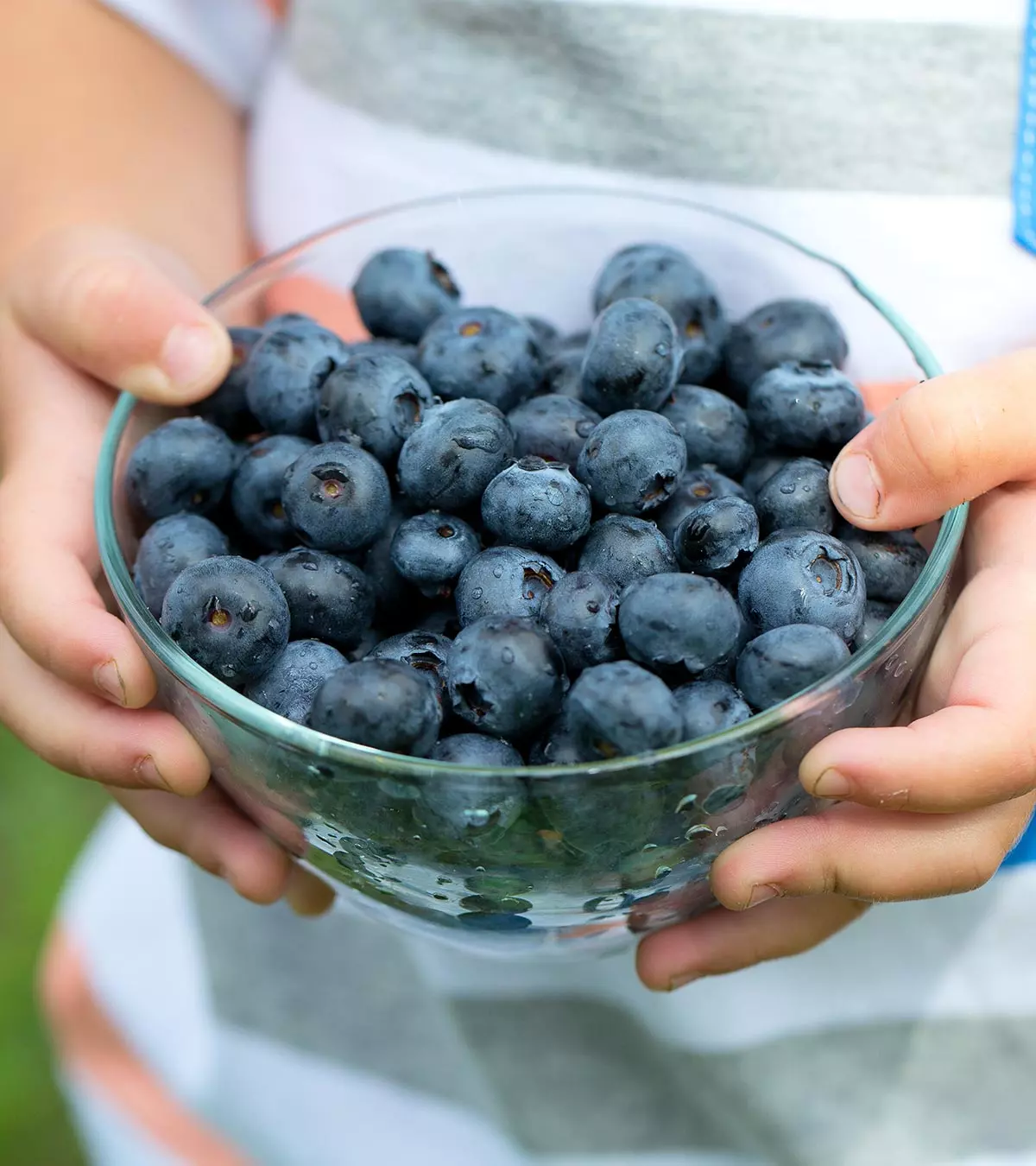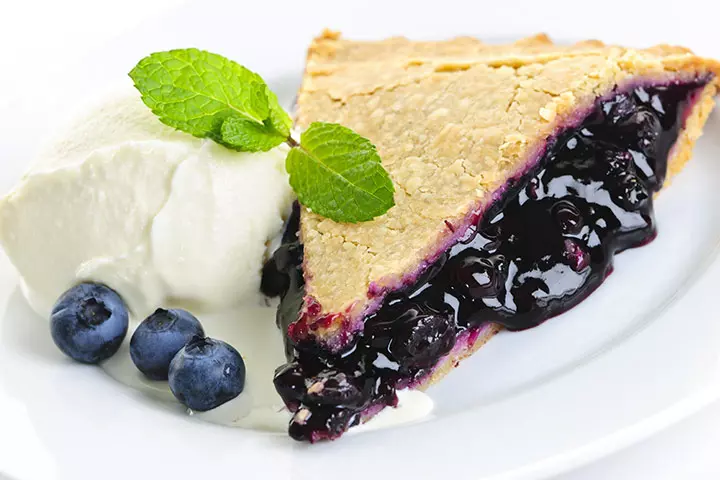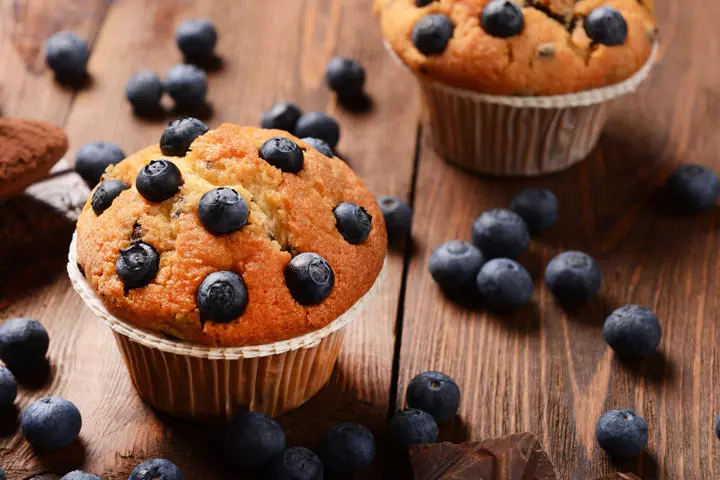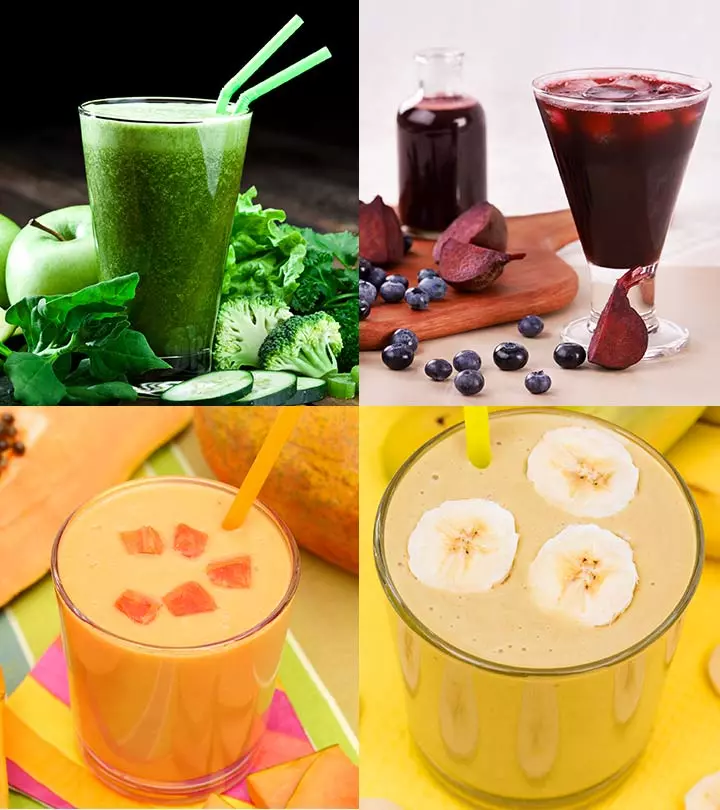
Image: ShutterStock
Blueberries are small, round, blue, or purple-colored berries that grow on flowering shrubs. This post brings you some interesting blueberry facts for kids. These berries are close relatives to other berries such as bilberries, grouse berries, or cranberries, and are native to North America. Blueberries are not only delicious and sweet but are also a powerhouse of nutrients that are essential for children’s growth and development. They are also regarded as ‘superfoods’ for children owing to their several health benefits and versatility in various dishes. Understanding these benefits can motivate children to make healthier food choices. Pediatricians and nutritionists worldwide commonly recommend them for babies to help with their healthy growth and functioning. Read on to know more interesting facts about blueberries that you can share with your children and inspire them to eat these berries.

Key Pointers
- Blueberries have a sweet taste and are considered a “superfood” for children due to their high nutritional value.
- They contain antioxidants that exhibit anti-aging properties and promote good heart health.
- Regular consumption of blueberries can prevent DNA damage, minimize the chances of developing cancer, lower cholesterol, control muscle damage, and improve brain function.
- Recipes such as Ice Cream Pie With Warm Blueberry Sauce, Blueberry Muffins, and Fruit Kebabs can be used to incorporate blueberries into the children’s diet.
Blueberry Facts For Kids
- The blueberries are small and round shaped fruits with a diameter of around 5-16 millimeters (8).
- These are summer harvest plants that are planted during the spring in parts of North America (9)
- Initially, they are green but change to a purplish blue color as they ripen.
- Blueberries are of two varieties, the high-bush blueberries that are grown in the US and the low-bush blueberries or the wild blueberries that are smaller in size but richer in antioxidants and minerals (10).
- Considered one of the most nutritious berries, they are powerhouses of energy and nutrients.
- 100g of blueberries contain 8.1mg of Vitamin C, 86mg of potassium, 13mg of phosphorus, and 12mg of calcium (11).

- Blueberries are a low-calorie fruit made up of approximately 85% water (11).
- The antioxidant compounds that are found in blueberries belong to the family of polyphenols and are called flavonoids (10).
- The antioxidant properties of blueberries protect the retina from damage thus preserving eyesight. (12). A specific group of flavonoids, known as anthocyanins, is particularly beneficial for slowing the aging process, reducing the risk of cancer, and protecting against heart disease (13).
- One group of flavonoids, anthocyanins, is especially useful for anti-aging, cancer prevention, and heart diseases.
- Maine in the US produces the most blueberries in the world (14).
- According to a USDA report, global blueberry production more than doubled from 439,000 metric tons to almost 1.0 million metric tons between 2010 and 2019 (15).
- A single blueberry bush can produce as many as 6,000 blueberries in a year (16).
- The silvery sheen on blueberries is called the “bloom.” It’s a natural protective coating that helps keep the fruit fresh and protects it from pests (16).
- Blueberries belong to the plant group called Vaccinium, which is part of the heath family (Ericaceae) (17).
- Blueberries are used as natural food dye.
- When picking blueberries, it is essential to ensure that the fruit is naturally cool, firm, plump, and dry with smooth skin (9).
- Fully-ripe blueberries tend to easily remove from the plant and can be consumed fresh, and also be dried or frozen for later use (9).
Health Benefits Of Blueberries For Kids
Blueberries are not just tasty; they offer a variety of health benefits that are especially important for kids. Incorporating these fruits into their diet can support their growth and development in many ways.
1. Acts against cancer cells
Regular consumption of blueberries helps prevent DNA damage and reduce the chances of developing cancer from a very early age (1).
The antioxidants in the fruit destroy the free radicals floating in the bloodstream and reduce oxidative DNA damage.
2. Lowers cholesterol
Blueberry juice or powder is beneficial for heart health as it helps in lowering cholesterol in the blood and prevents numerous heart diseases. Consuming blueberries in any form from an early age can help lower cholesterol and promote cardiovascular heart (2).
3. Improves brain function

Blueberries contain antioxidants that help reduce oxidative damage to the brain cells and improve the memory of your children. Consumption of blueberries can help your child learn and memorize things better, assist in the brain’s cognitive development, and reduce stress in the body and the mind (3) (4).
4. Controls muscle damage
Blueberries are rich in antioxidants, particularly anthocyanins, which possess anti-inflammatory properties that can help reduce muscle soreness and damage caused by strenuous activities (5). This benefit can support children’s muscle recovery after physical play or exercise.
 Quick tip
Quick tip5. Boosts the immune system
Studies show eating blueberries can increase the number of natural killer (NK) cells in the body. These cells can help fight off viruses and other harmful germs. Additionally, the flavonoids in blueberries also help lower the chances of getting infections like colds and sore throats (6).
6. Supports digestive health
Blueberries are a good source of prebiotics, which are natural compounds that help feed the healthy bacteria in the gut. They are also a good source of dietary fiber, which promotes healthy digestion and can prevent constipation in children (7).
Easy Blueberry Recipes For Kids
Eating blueberries in fruit form may be boring for your kid. Include the fruit in various recipes to ensure that your child is having sufficient quantities of it. Here are a few recipes that you can try.
1. Ice cream pie with warm blueberry sauce

Ingredients
- 1 refrigerated pie crust
- 1/3 cup of fine sugar
- ¼ cup of water
- 2 bowls of freshly grated blueberries
- 1 tbsp of corn flour
- 2 pints of vanilla ice cream
- 1/8 tsp of cinnamon, finely ground
- Tart pans of 4 inches each
How To
- Set the oven at a temperature of 375 degrees and grease the bottom and sides of the tart pans with vegetable oil or butter.
- Divide the pie crust into four equal portions and turn round till they are larger than the pans. After that, press the dough slightly into the tart pans.
- Trim the excess dough around the pan and line the dough with butter paper or foil.
- Now stuff the dough with pie weights or dried beans.
- Put the pans on a baking sheet, set the oven and bake it for ten minutes straight.
- Do away with the weights and paper, and set aside the baked pie for cooling.
- During the baking time, you can heat up the saucepan and cook the blueberries by adding sugar, water, cornstarch, and cinnamon till the sauce has a viscous texture.
- Take away from the stove and set it to cool for a while. Eliminate the crusts from pans, pour the cooked tarts on the serving plates. At the sides, place two scoops of ice cream.
- Pour the prepared blueberry sauce over the top of the tarts and enjoy the dessert.
2. Blueberry muffins

Ingredients
- 2 cups of flour
- ¾ cup of granulated sugar
- 2 tsp of baking powder
- ½ tsp of kosher salt
- ½ cup unsalted butter, previously melted and kept for cooling
- 2 large and fresh eggs
- 1 ½ cups of blueberry
- 2 tbsp of turbinado sugar for flavoring
How To
- Set the oven to 375° F and keep 12 muffin cups or molds along with paper liners or coat them with butter for a greasy effect.
- Take a large bowl, add the flour, baking powder, and salt and whip them together to form a fine mixture.
- Take a medium sized bowl and pour the granulated sugar, milk, eggs and butter and whisk them together. You can also add it to the flour mixture.
- Add the blueberries but do not over mix.
- Pour the batter into the prepared muffin cups and add some turbinado sugar, if desired.
- Now bake in the oven for 20 to 25 minutes and cool the baked items for five minutes. Shift the items to a wire shelf to cool completely or serve the healthy blueberry muffins for kids right away, if desired.
 Quick tip
Quick tip3. Fruit kebabs with blueberries

Ingredients
- 3 cups blueberries
- 1⁄3 cup cream cheese
- 2 tbsp apricot preserves
- 2 cups watermelon or pineapple
- Pieces of apples
How To
- Blend two cups of the blueberries, cheese and apricot preserves together.
- Move it to a bowl and refrigerate it.
- On bamboo skewers, prepare kebabs with apples, blueberries and watermelon pieces.
- Serve them with the blueberry dip.
4. Blueberry smoothie

Ingredients
- 1 cup blueberries
- 1 banana
- 1 cup yogurt
- 1 cup milk
How To
- Combine all ingredients in a blender.
- Blend until smooth and creamy.
- Pour into a glass and enjoy!
- Add ice based on your preference.
Frequently Asked Questions
1. What is the recommended daily intake of blueberries?
You may serve a handful of blueberries (fresh, raw, or as a part of a dessert) to your child during their snack time (18).
2. Why do children like blueberries?
Children may like fresh blueberries for their tart-to-sweet taste and the various ways the fruit can be consumed as part of delicious dishes (12).
3. Can blueberries help boost the immune system in children?
Blueberries are rich in vitamins, particularly vitamin C, which is known to support immune function. Blueberries also contain antioxidants that help protect the body from oxidative stress and inflammation, further supporting overall immune health (2).
4. Are blueberries a good option for kids with allergies?
Blueberries rarely cause allergies in children. They are generally regarded as safe for children with allergies. Nevertheless, it’s important to note that some children may have allergies to specific fruits, including blueberries (rarely). A single-case study reported a case of a severe allergic reaction to blueberries (19).
5. How can blueberries be stored to maintain their freshness and quality?
Store the unwashed blueberries in a container or a breathable bag in the refrigerator. Do not wash the berries until ready to consume them, as moisture can promote spoilage. Blueberries typically last up to a week when stored properly (20).
6. Can blueberries be grown at home? If so, how?
Yes, blueberries can be successfully grown at home. Blueberries grow well in optimal sunlight and loose and acidic soil. Plant two or more plant varieties to ensure successful pollination. Blueberry plants have a slow growth rate and typically reach their full size in eight to ten years. During each winter, it is beneficial to prune out old, weak, and dead wood to maintain plant health (20).
7. How do blueberries compare to other berries regarding taste, texture, and nutritional value?
Blueberries have a sweet and tangy flavor with a firm texture. Compared to raspberries, they contain more sugar but offer a range of phytonutrients. On the other hand, blackberries have a sweet-tart flavor, a soft and juicy texture, and are high in antioxidants and fiber. Strawberries have a sweet and slightly tangy taste, a juicy and grainy texture, and are rich in antioxidants and essential nutrients (21).
Talking to your little one about intriguing blueberries facts for kids could leave them asking more for these nutritious little fruits. You may also share these berries’ wide range of health benefits with your children. Blueberries are packed with several vital nutrients required for the proper functioning of the body. Also, their sweet and delicious taste makes them one of the most-loved fruits by kids. You may try various blueberry recipes, such as muffins, pancakes, smoothies, jams, and syrups to give them a yummy dessert after a meal while also serving this tasty fruit.
Infographic: How Does Eating Blueberries Benefit Children?
The unique blue color and sweet taste of blueberries will surely attract your children’s attention, whether in a milkshake or their favorite dishes. So, if your child loves eating these fresh and juicy fruits, know that it also offers various health benefits, as mentioned in the infographic below.
Some thing wrong with infographic shortcode. please verify shortcode syntaxIllustration: Blueberries For Kids: Nutritional Facts Benefits And Recipes

Image: Stable Diffusion/MomJunction Design Team
References
- Blueberries: Increase Antioxidant Activity in the Blood.
https://www.aicr.org/cancer-prevention/food-facts/blueberries/ - The Health Benefits of Blueberries.
https://health.clevelandclinic.org/benefits-of-blueberries - A brain boost: Top brain foods for kids.
https://blog.erlanger.org/2018/03/16/brain-boost-top-brain-foods-kids/ - 6 Ways Blueberries Can Improve Brain Health.
https://blog.ochsner.org/articles/6-ways-blueberries-can-improve-brain-health/ - Yanita McLeay et al; (2012); Effect of New Zealand blueberry consumption on recovery from eccentric exercise-induced muscle damage.
https://pmc.ncbi.nlm.nih.gov/articles/PMC3583121/ - 8 Superfoods for Your Immune System.
https://www.aarp.org/health/healthy-living/superfoods-for-immune-health/ - 6 Reasons to Eat More Blueberries.
https://stvincents.org/about-us/news-press/news-detail?articleId=57627&publicid=745 - Bunches of Berries.
https://agclassroom.org/matrix/lesson/print/857/ - Blueberries.
https://extension.illinois.edu/blogs/prairies-perennials/2025-06-12-blueberries - Wild Blueberry Concentrations: Antioxidants, Vitamins and Minerals.
https://extension.umaine.edu/blueberries/factsheets/quality/wild-blueberry-concentrations-antioxidants-vitamins-and-minerals/ - Blueberries, raw.
https://fdc.nal.usda.gov/food-details/2346411/nutrients - What’s New with the Blueberry?
https://health.choc.org/whats-new-blueberry/ - Roberto Mattioli et al; (2025); Anthocyanins: A Comprehensive Review of Their Chemical Properties and Health Effects on Cardiovascular and Neurodegenerative Diseases.
https://pmc.ncbi.nlm.nih.gov/articles/PMC7504512/ - Blueberries.
https://www.maine.gov/doe/sites/maine.gov.doe/files/inline-files/Blueberries.pdf - Blueberries Around the Globe – Past, Present, and Future.
https://www.fas.usda.gov/data/blueberries-around-globe-past-present-and-future - Blueberries Growing Guide.
https://kidsgardening.org/resources/growing-guide-blueberries/ - Blueberries.
https://www.ars.usda.gov/pacific-west-area/logan-ut/pollinating-insect-biology-management-systematics-research/docs/blueberries/ - Grab A Boost Of Blue.
https://blueberry.org/wp-content/uploads/2025/06/Blueberry-Nutrition-Infographic.pdf - Possible anaphylaxis to blueberry: potential cross-reactivity with other berries.
https://www.aaaai.org/allergist-resources/ask-the-expert/answers/old-ask-the-experts/anaphylaxis-to-blueberry - Growing blueberries in the home garden.
https://extension.umn.edu/fruit/growing-blueberries-home-garden - Berry Good for Your Heart.
https://www.hopkinsmedicine.org/health/wellness-and-prevention/berry-good-for-your-heart
Community Experiences
Join the conversation and become a part of our nurturing community! Share your stories, experiences, and insights to connect with fellow parents.
Read full bio of Dr. Elizabeth Roberts
Read full bio of Trisha Chakraborty
Read full bio of Swati Patwal
Read full bio of Dr. Joyani Das


















